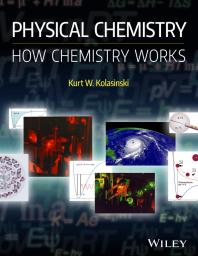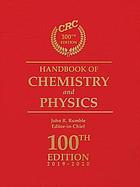Finding Chemistry & Physics Books

The best way to find Chemistry and Physics books is to search the library catalog.
You can also find chemistry and physics books by browsing the library shelves. Most of the Chemistry and Physics books will be in the same section near other books in the science area.
Try these call numbers:
Q - Science

QC - Physics

QD - Chemistry

Chemistry Books

Chemistry 2e
Chemistry 2e is designed to meet the scope and sequence requirements of the two-semester general chemistry course. The textbook provides an important opportunity for students to learn the core concepts of chemistry and understand how those concepts apply to their lives and the world around them. The book also includes a number of innovative features, including interactive exercises and real-world applications, designed to enhance student learning. The second edition has been revised to incorporate clearer, more current, and more dynamic explanations, while maintaining the same organization as the first edition. Substantial improvements have been made in the figures, illustrations, and example exercises that support the text narrative.

Physical Chemistry : How Chemistry Works
Physical Chemistry: How Chemistry Works takes a fresh approach to teaching in physical chemistry. This modern textbook is designed to excite and engage undergraduate chemistry students and prepare them for how they will employ physical chemistry in real life. The student-friendly approach and practical, contemporary examples facilitate an understanding of the physical chemical aspects of any system, allowing students of inorganic chemistry, organic chemistry, analytical chemistry and biochemistry to be fluent in the essentials of physical chemistry in order to understand synthesis, intermolecular interactions and materials properties. For students who are deeply interested in the subject of physical chemistry, the textbook facilitates further study by connecting them to the frontiers of research. - Provides students with the physical and mathematical machinery to understand the physical chemical aspects of any system.

Analytical Chemistry 2.1
As currently taught in the United States, introductory courses in analytical chemistry emphasize quantitative (and sometimes qualitative) methods of analysis along with a heavy dose of equilibrium chemistry. Analytical chemistry, however, is much more than a collection of analytical methods and an understanding of equilibrium chemistry; it is an approach to solving chemical problems. Although equilibrium chemistry and analytical methods are important, their coverage should not come at the expense of other equally important topics.
The introductory course in analytical chemistry is the ideal place in the undergraduate chemistry curriculum for exploring topics such as experimental design, sampling, calibration strategies, standardization, optimization, statistics, and the validation of experimental results. Analytical methods come and go, but best practices for designing and validating analytical methods are universal. Because chemistry is an experimental science it is essential that all chemistry students understand the importance of making good measurements.

CRC handbook of chemistry and physics : a ready-reference book of chemical and physical data.
Basic constants, units, and conversion factors -- Symbols, terminology, and nomenclature -- Physical constants of organic compounds -- Properties of the elements and inorganic compounds -- Thermochemistry, kinetics, electrochemistry, and solution chemistry -- Fluid properties -- Biochemistry -- Analytical chemistry -- Molecular structure and spectroscopy -- Atomic, molecular, and optical physics -- Nuclear and particle physics -- Properties of solids -- Polymer properties -- Geophysics, astronomy, and acoustics -- Practical laboratory data -- Health and safety information -- Appendix A. Sources of physical and chemical data.

General, organic, and biological chemistry : structures of life
Chemistry in our lives -- Chemistry and measurements -- Matter and energy -- Atoms and elements -- Nuclear chemistry -- Ionic and molecular compounds -- Chemical reactions and quantities -- Gases -- Solutions -- Reaction rates and chemical equilibrium -- Acids and bases -- Introduction to organic chemistry: hydrocarbons -- Alcohols, phenols, thiols, and ethers -- Aldehydes and ketones -- Carbohydrates -- Carboxylic acids and esters -- Lipids -- Amines and amides -- Amino acids and proteins -- Enzymes and vitamins -- Nucleic acids and protein synthesis -- Metabolic pathways for carbohydrates -- Metabolism and energy production -- Metabolic pathways for lipids and amino acids.

Chemistry: Atoms First - 2e
Chemistry: Atoms First 2e is a peer-reviewed, openly licensed introductory textbook produced through a collaborative publishing partnership between OpenStax and the University of Connecticut and UConn Undergraduate Student Government Association.
This text is an atoms-first adaptation of OpenStax Chemistry 2e. The intention of “atoms-first” involves a few basic principles: first, it introduces atomic and molecular structure much earlier than the traditional approach, and it threads these themes through subsequent chapters. This approach may be chosen as a way to delay the introduction of material such as stoichiometry that students traditionally find abstract and difficult, thereby allowing students time to acclimate their study skills to chemistry. Additionally, it gives students a basis for understanding the application of quantitative principles to the chemistry that underlies the entire course. It also aims to center the study of chemistry on the atomic foundation that many will expand upon in a later course covering organic chemistry, easing that transition when the time arrives.
Physics Books

50 Physics Ideas You Really Need to Know
In 50 Physics Ideas You Really Need to Know Joanne Baker will uncover the physics all around us, from basic concepts like gravity, light and energy through to the complexities of quantum theory, chaos and dark energy.

University Physics I: Classical Mechanics
This is a “minimalist” textbook for a first semester of university, calculus-based physics, covering classical mechanics (including one chapter on mechanical waves, but excluding fluids), plus a brief introduction to thermodynamics. The presentation owes much to Mazur’s The Principles and Practice of Physics: conservation laws, momentum and energy, are introduced before forces, and one-dimensional setups are thoroughly explored before two-dimensional systems are considered. It contains both problems and worked-out examples.

University Physics Volume 1
University Physics is a three-volume collection that meets the scope and sequence requirements for two- and three-semester calculus-based physics courses. Volume 1 covers mechanics, sound, oscillations, and waves. This textbook emphasizes connections between theory and application, making physics concepts interesting and accessible to students while maintaining the mathematical rigor inherent in the subject. Frequent, strong examples focus on how to approach a problem, how to work with the equations, and how to check and generalize the result.

University Physics Volume 2
University Physics is a three-volume collection that meets the scope and sequence requirements for two- and three-semester calculus-based physics courses. Volume 1 covers mechanics, sound, oscillations, and waves. Volume 2 covers thermodynamics, electricity and magnetism, and Volume 3 covers optics and modern physics. This textbook emphasizes connections between theory and application, making physics concepts interesting and accessible to students while maintaining the mathematical rigor inherent in the subject. Frequent, strong examples focus on how to approach a problem, how to work with the equations, and how to check and generalize the result.

University Physics Volume 3
University Physics is a three-volume collection that meets the scope and sequence requirements for two- and three-semester calculus-based physics courses. Volume 1 covers mechanics, sound, oscillations, and waves. Volume 2 covers thermodynamics, electricity and magnetism, and Volume 3 covers optics and modern physics. This textbook emphasizes connections between between theory and application, making physics concepts interesting and accessible to students while maintaining the mathematical rigor inherent in the subject. Frequent, strong examples focus on how to approach a problem, how to work with the equations, and how to check and generalize the result.
Other Libraries
 If you can't find the book you want you can always check the WorldCat Catalog to see if it is in a nearby library. SFC Library is a member of Academic Libraries of Brooklyn (ALB). If you request an ALB card from the Reference Desk you can visit six other academic libraries.
If you can't find the book you want you can always check the WorldCat Catalog to see if it is in a nearby library. SFC Library is a member of Academic Libraries of Brooklyn (ALB). If you request an ALB card from the Reference Desk you can visit six other academic libraries.
You can also request an Interlibrary Loan from another library by filling out the form below.